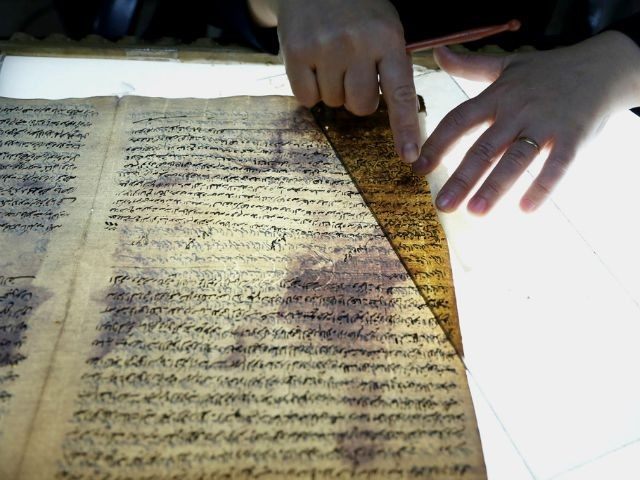The Baghdad National Library is working hard to digitalize their priceless papers and manuscripts before militant groups like the Islamic State (ISIS/ISIL) move in. The radical Islamic group is notorious for destroying or looting libraries and museums.
The 2003 US invasion destroyed “thousands of documents.” People set fire to the library, which destroyed “25 percent of its books and some 60 percent of its archives.” But the librarians and academics hope they can save what is left. These pieces of paper are rich in human history, “holding the true stories of sultans and kings; imperialists and socialists; occupation and liberation; war and peace.” The paper is so delicate that a specialized lighting must be used. They are testing this lighting on documents from 1939 to 1958, when Faisal II ruled Iraq.
“Once restoration for some of the older documents from the Ottoman era, 200 to 250 years ago, is completed, we will begin to photograph those onto microfilm,” explained Mazin Ibrahim Ismail, head of the library’s microfilm department.
The process is slow and tedious, but a must to preserve history:
The restoration process is nothing short of microsurgery, and the type damage to each document is a story — and a puzzle — on its own. Some manuscripts are torn from overuse and aging; others are burned or stained from attack or sabotage. And then there are some that were completely fossilized over time — the combined result of moisture and scorching temperatures — looking instead like large rocks dug up from the earth.
—
Technicians sterilize manuscripts and documents for 48 hours, washing them of dust and other impurities that accumulated over time. Then, they go page by page using Japanese tissue, specialized paper for book conservation and restoration, to either fill in torn edges or layer the more-delicate documents with a sheer coating to make them more durable.
“Those are the most difficult books to restore,” stated restoration department employee Fatma Khudair. “We apply steam using a specialized tool to try to loosen and separate the pages. Sometimes, we are able to save those books and then apply other restoration techniques, but with others, the damage is irreversible.”
In February, ISIS burned down the Mosul public library, which was home to over 8,000 rare books and manuscripts. The terrorists raided the Central Library of Mosul in December to destroy all non-Islamic books. The library was “the biggest repository of learning the northern Iraqi town.” More than likely the terrorists destroyed “Iraq newspapers dating to the early 20th century, maps and books from the Ottoman Empire, and book collections contributed by about 100 of Mosul’s establishment families.” After that raid, the militants targeted the library at the University of Mosul. They burned science and culture textbooks in front of the students.
In January, NPR interviewed Iraqi Father Najeeb Michaeel and Texan Father Columba Stewart who are determined to rescue Christian artifacts. In a safe house in Erbil, 57 miles east of Mosul, the two men stock any relics they can find, including huge piles of books and manuscripts. While in Mosul, Father Michaeel photographed and digitalized as many books as he could with help from Father Stewart’s Hill Museum and Manuscript Library in Minnesota, but an impending attack by the Islamic State halted his efforts. He packed up a truck full of the collections to save them.
ISIS also targets museums and preserved heritage sites. Militants destroyed the sites of Khorsabad, Nimrud, and Hatra over one weekend in March. Two months later, the terrorist group invaded and captured Palmyra, Syria.
“IS members on Saturday destroyed the Lion of al-Lat, which is a unique piece that is three metres [10ft] tall and weighs 15 tonnes,” declared Maamoun Abdelkarim, Syria’s antiquities director. “It’s the most serious crime they have committed against Palmyra’s heritage.”
Abdelkarim said his team managed to save many ancient artifacts before the ISIS invasion. However, officials and authorities could not do anything about the temples and buildings in Palmyra that earned the city a UNESCO stamp of approval.
“Before taking control of the city [by ISIS], a large number of the items were moved into Damascus, but thousands of the ancient items and sites still remain inside the city,” said Abdulkarim. “Many are heavy and big, so difficult to relocate.”

COMMENTS
Please let us know if you're having issues with commenting.